Hello, everyone! I am glad I have come back to being active again here on bitLanders. Hopefully motivation would linger on me for a longer time. Well, dear motivation is welcome to stay forever if it wants to. You know, accomplishing things is one of the best feelings because it gives you the sense of freedom after. (Haha!) So why am I telling all these for my intro? Well, happy to say that I am finally on my last blog for my Baguio City visit with my family. After almost four months of fighting procrastination! Oh, yes!
My last entry for this blog series is about food. We don't usually look for other restaurants and fast food chains other than those which we trusted and always go to. But on our last day, I successfully got everyone to eat lunch at a popular ramen restaurant named Ramen Nagi.
WHAT IS RAMEN?
Ramen is one of the most popular Japanese noodle soup meal. It consists of the noodles, broth, soup base, and toppings. There are many flavors of ramen so the ingredients varies on each. Apart from it, ramen has three types: hot ramen, cold ramen, and tsukemen.
(video source: Food Network via Youtube)
A brief explanation about ramen.
Ramen is said to have originated in China and was brought by the Chinese to Japan. What the Chinese had introduce to the Japanese though was only the hot ramen. And knowing Japan for its quirkiness and eye for innovation, the cold ramen and tsukemen was born later on.
THE UNIVERSAL NOODLE RAMEN NAGI
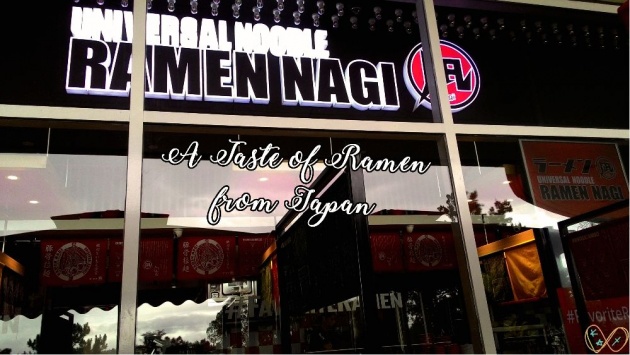
(image source: Katsanslimites)
Huge signage of Ramen Nagi.
Ramen Nagi is a Japanese restaurant originating in Shinjuku, Japan by ramen guru Ikuta Satoshi. Satoshi established Ramen Nagi on 2006 and had easily sprouted branches within Japan. But the Ramen Nagi craze doesn't just end in Japan as it had spread throughout other Asian countries too like China, Hong Kong, Taiwan, Indonesia, Signapore, and Philippines(last 2013).
(video source: Straits Times via Youtube)
Ramen master Ikuta Satoshi prepares a Butao ramen.
Ramen Nagi offers an authentic taste of Japanese ramen. Part of their ingredients are imported from Japan, that's why Ramen Nagi assures that their customers get to experience eating real ramen.
The first branch of Ramen Nagi in the Philippines was opened at SM Aura and as of August 2017, Ramen Nagi has 15 branches in the country where 13 of which are in Manila while the remaining two branches are in Baguio and Pampanga. The Ramen Nagi in Baguio City was the latest addition to the Ramen Nagi branches in the country.
RAMEN NAGI AT SM CITY BAGUIO
My family arrived at SM City Baguio around 10 in the morning to have an early lunch before heading out to our itinerary for the day. After buying some muffins at Cinnabon, we went up to the second floor where Ramen Nagi is.
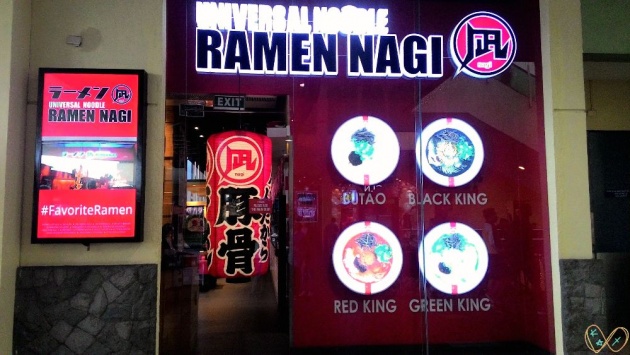
(image source: Katsanslimites)
The specialty ramen of Ramen Nagi displayed on the side of the restaurant.
Upon reaching the restaurant, we were surprised to see no customers around although the door is already open and staffs could be seen inside busy with their work. So we stood outside looking at their ramen poster posted on the entrance. A few moments later, a staff went out to assist us.
The staff was patient enough to discuss each ramen when we couldn't make up our minds on what to order. I know ramen but the variation of flavors on their menu were very new to my ears. Thank goodness my mom thought of asking their bestseller ramen and that's what we ordered.
We chose to stay at their outdoor tables since the weather is cold and we have a nice view of the city too. Surprisingly, that morning felt really cold that I even have to hide my hands inside the pocket of my jacket to keep it warm. The cold weather makes us more excited to slurp some hot ramen!
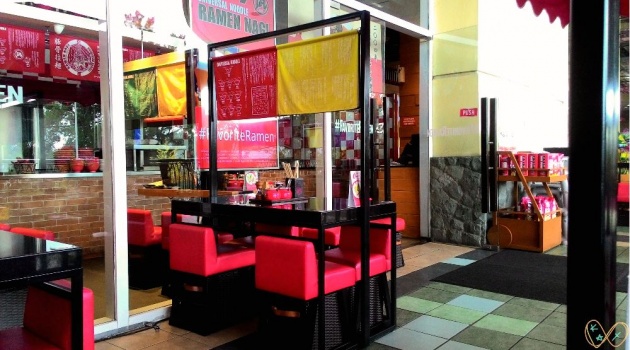
(image source: Katsanslimites)
Cute red chairs for Ramen Nagi in Baguio City.
After our final orders were taken by the staff, I kept myself busy by looking around i and took the chance to snap some photos too while there were no other people around yet. The first thing I noticed are the cute chairs. They looked small but comfortable to seat on. The backrest of the chair was also short just enough to support our waists when you lean back. The seats look very Japanese for me. (Haha!)
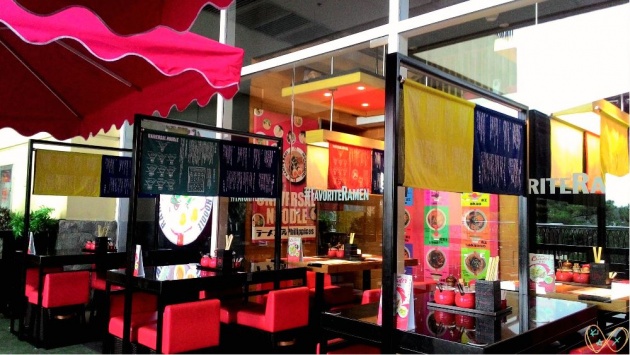
(image source: Katsanslimites)
Different colors of noren hung on each table.
Next thing to appreciate are the tables. Each table has that curtain-like banner called "Noren" which gives off a traditional Japanese ramen stall vibe. (It reminds me of the Ichiraku Ramen in the anime series Naruto where they push aside the curtain to enter the ramen stall. Naruto's favorite food is ramen, by the way!)
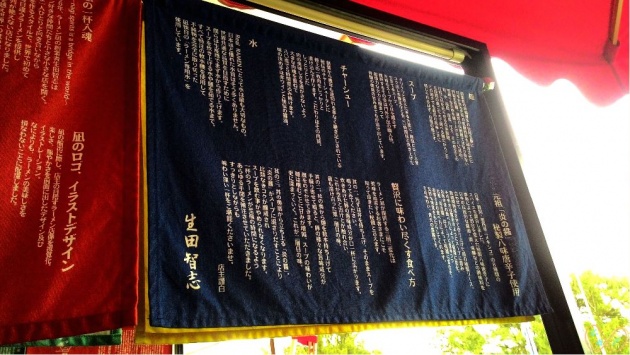
(image source: Katsanslimites)
A close up look of the noren of our table.
The curtains has Japanese characters printed on it which I cannot understand because most of it was written in Kanji. But I guess it's an explanation about ramen since I read something like "soup" and "chashu".
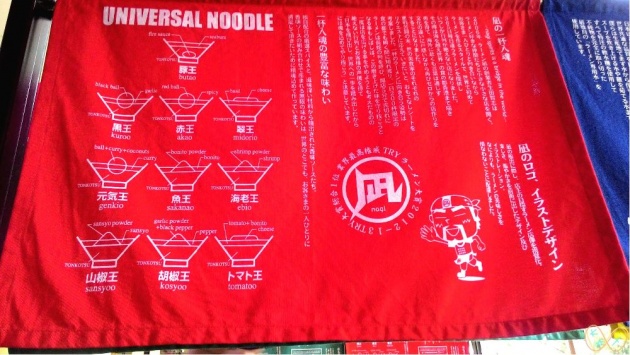
(image source: Katsanslimites)
An illustration of Ramen Nagi's ramen printed on the noren.
The other half of the curtain though has illustrations which explains the parts of their ramen. This is such a brilliant way of educating their customers of their dishes especially to the first-timers and those who are not very familiar of ramen. You'll surely keep yourself busy with their amazing setup while waiting for your food to be served.
After a good 15 minutes of waiting, our foods were served. We have no complaints while waiting since we were busy appreciating the place and we were not totally hungry yet even though we haven't eaten our breakfast. Plus, the weather is good so all of us were in a nice mood.
BUTAO RAMEN
We ordered their best-seller Butao or Original King ramen to be safe since it's our first time. It's a recommended flavor for first-timers. Butao has a "tonkotsu" or pork bone broth. Parts of this ramen as seen on the illustration printed on the banner I was talking about previously were tonkotsu, fire sauce, and seaburn. I don't understand what the fire sauce and seaburn literally mean because I am not a food expert but I surely noticed the thinly sliced pork meat (chashu) and lots of chopped green onion. There are other ingredients too like the kikurage (wood ear mushroom) which I just knew now while writing this blog.
A bowl of Butao ramen costs Php 390, if I remember it correctly. We originally thought of buying a bowl for each of us but then the staff said that a bowl can be enough for 2 persons, so my mom and I agreed and ended up sharing on one Butao order. The staff gave me a smaller bowl too.
Itadakimasu! (Let's eat!)
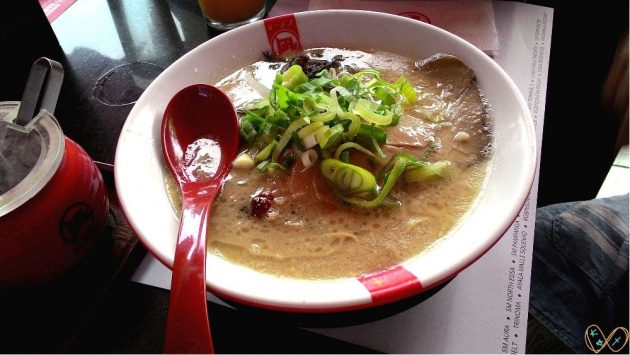
(image source: Katsanslimites)
The Butao ramen, Ramen Nagi's best seller ramen.
We were surprised with the generous amount of food on the bowl. I got my portion of the Butao ramen and I still hardly finished it. It's definitely good enough for 2 persons.
Regarding its taste, well, I have not complaints. I love the creaminess of the soup. The pork was thin and soft, delicious and easy to chew. The other vegetables just went so well with the ramen and I love that it has a tinge of spiciness too. You can choose how spicy you want your ramen to be. My mom chose the lowest level of spiciness. (Hehe!) My half portion of Butao was so good that even though I could hardly finish it, I would still want a whole bowl all for myself. (It might just take some time for me to eat it all up. Hehe!)
There were also a couple of condiments at the table for you to add on your ramen. I just put a good amount of each condiment on my bowl even though they were unfamiliar to me. If it adds good taste for the ramen then why not, right? Although I'm guessing one of the condiments was ground sesame seeds.
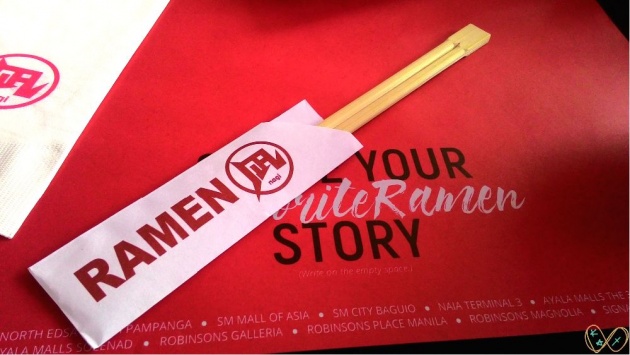
(image source: Katsanslimites)
Eat ramen with chopsticks!
A couple of disposable chopsticks were also placed on each table which is good because you no longer have to ask a staff for chopsticks if you want to use one or need to replace it just in case you accidentally broke or dropped it on the floor. But don't worry if you do not know how to use chopsticks. If I remember it clearly, they also give spoon and fork along with your meal. However, I wanted to experience how to eat the Japanese way. So I put the spoon and fork on the side and split the chopsticks in half.
Other ramen flavors on their menu are Black King(Kuroo), Red King(Akao), Green King(Midorio), and the Limited King. Limited King are their seasonal ramen like the Ebi King which is a shrimp flavor. (All the color kings reminds me of the anime K. Hehe.)
PORK KATSU ROLLS
I personally chose the Pork Katsu Rolls as one of our side dishes. I like how the word "katsu" sounds because it's similar to my name. (Haha!) I was enticed by its photo on the menu and so I decided that we should get one. Well, I wasn't disappointed when the Pork Katsu Rolls arrived on our table. What you see is what you get. It's exactly how it was on the photo and I love it.
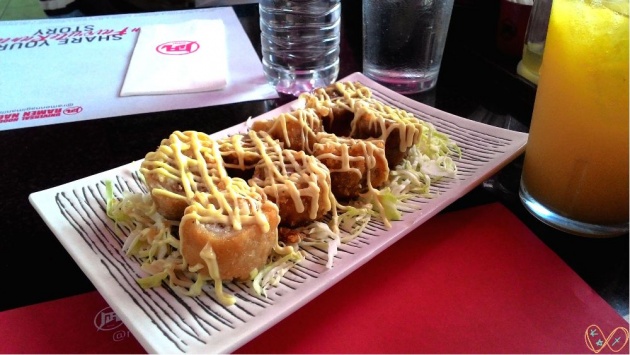
(image source: Katsanslimites)
Pork Katsu Rolls is my favorite!
The Pork Katsu Rolls is a pork belly with cheese on a crunchy wrapper and drizzled with Ramen Nagi's special sauce. It also has lots of finely chopped cabbage gorgeously scattered on the sides too. A plate of Pork Katsu Rolls which has eight pieces costs Php 295.
The price for an order may seem expensive but I want to let you know that this is probably my most favorite food on their menu. It's 100% delicious. Pork Katsu Rolls certainly won Katsanslimites' approval.
CHICKEN KARAAGE
The other side dish ordered by my brother is the Chicken Karaage. It's a chicken fillet marinated on a special sauce, wrapped on a special breading and deep fried. It also comes with lots of finely chopped cabbage and a mix of mustard and mayonnaise dip.
I haven't taken a photo of it but you can refer on Ramen Nagi's Facebook post for a sample photo.
A plate or one order of Chicken Karaage costs Php 250. I've only eaten a piece of it and I'd say it tastes good but has nothing special in my opinion. Maybe the Pork Katsu Rolls already had won my heart that moment that it gave me a higher expectation for the Chicken Karaage. (Hehe!)
Aside from that, we paired our meal with a glass of mango juice which costs Php 80 each.
GREAT CUSTOMER SERVICE
Last but not the least, a good menu isn't only the criteria for a good restaurant. Hence, how the staff handle their customers must also be considered. While waiting for our bill, a staff came to our table and handed us a tablet and asked us to rate their service. I don't know if this is how it goes with other restaurants too but I am amazed that rating for their customer service is already electronically done which means it is accurately stored on their database and could be instantly reviewed and monitored by the person in charge of tracking the staffs' performances and customers' feedbacks.
I easily gave them a perfect score of 5/5 on each category because we were very satisfied. The staff patiently discussed each ramen for us and took care of our orders. She also seemed so kind and smiles to the customers which made me feel at ease. They have cool-looking uniforms and communicate with other staffs (surprise) in Japanese language or Nihongo! My ears was surprised when I heard the staff shout our orders in Nihongo and the chef replied back in Nihongo as well. Knowing that I am a sucker of anything Japanese, my family immediately asked me what they were saying like I am a Japanese language expert. Of course, I am not going to lie so I honestly told them that I only understood a word or two. (Haha!) I wonder if one of the restaurant's qualifications for their staffs is being proficient in Nihongo. Or probably the staffs were really trained with some phrases needed for the business because I have also seen Japanese people coming in to eat. The way they spoke Nihongo was good, by the way.
I also love that they welcome customers with the word "Irasshaimase!" (Welcome!) and thanks them with "Arigatou gozaimasu!" (Thank you very much!) It was a fun and amazing feeling but it's also kind of awkward because all of them would greet you when you enter and leave. Yup, even the chefs inside would shout irasshaimase and arigatou gozaimasu at you.
OISHII! (DELICIOUS!)
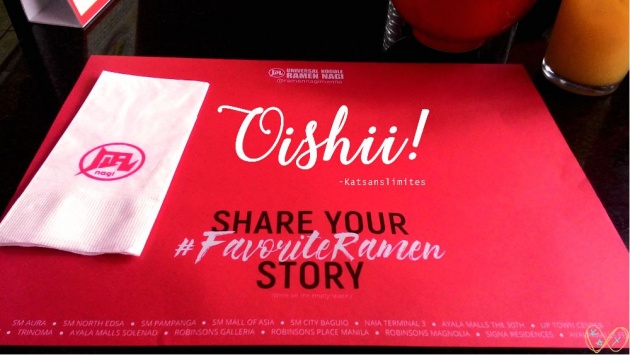
(image source: Katsanslimites)
Ramen Nagi encourages their customer to write on the paper placemat. Does doing it digitally counts? Because I have no pen that moment. (Haha!)
Ramen Nagi is among today's top Japanese ramen restaurants in the Philippines. Ramen has been gaining popularity in the country and all over the world, and so I could foresee Ramen Nagi getting lots of luck in the ramen business.
Honestly, I didn't know about Ramen Nagi at all when we came to Baguio City. We just happened to pass by it when we were looking for a place to dine the night before. I got so curious as there were lots of people eating at Ramen Nagi that night and so I considered in my mind that we should try eating our lunch there the next day. And I wasn't wrong because we had a very good experience with Ramen Nagi. (I didn't even know that it was indeed a restaurant originating from Japan until I was writing this blog. Lol! I am dumbfounded.)
The foods weren't just "oishiisou" (delicious-looking) but they were "mecha oishii" (very delicious) too. It was my first ramen experience and I am glad I had it on Ramen Nagi. It's true that when you've tasted an authentic ramen, your expectations for ramen goes up. I remember eating my second ramen here in our province and I felt disappointed because it doesn't tastes as good as the one in Ramen Nagi. (Haha!)
I wish there's a Ramen Nagi store nearby Dagupan City so I could have those delicious ramen anytime I want. I would absolutely recommend this restaurant to everyone. Their foods are amazing but a little pricey. Our bill was around Php 1,300 for four people. But I think the price is reasonable for an authentic Japanese restaurant, right? And to think that we only bought two bowls of Butao ramen instead of four had also saved us some money.
So I better end this blog now before I get hungry and crave for a bowl of ramen from Ramen Nagi! You can visit their official Facebook page (/RamenNagiManila) and Instagram account (@ramennagimanila) for updates.
Gochisousama deshita! (Thanks for the food!)
Thanks for reading!
✧ Katsanslimites



